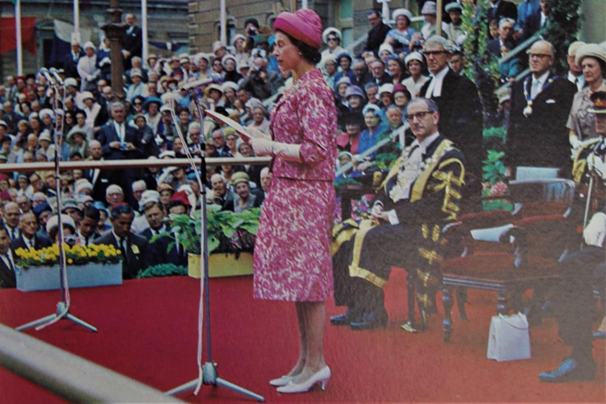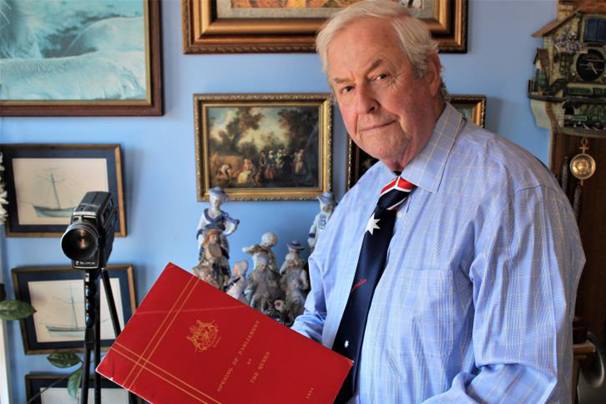With the passing of Her Majesty Queen Elizabeth II, it is well to remember her connection to
Tasmania.

Her Majesty, Queen Elizabeth II during her 1963 Tasmanian tour at the steps of the Town Hall.
Sitting, Mayor Soundy
When she took the oath at her coronation on the 2nd of June 1953 became monarch of a
number of countries, plus Head of the Commonwealth and ruler of an existing empire. At
the time of her passing she was the Queen of 15 countries and the Head of a
Commonwealth consisting of 53 countries. She was a patron of 600 charities. There have
been enormous changes since 1953. On 9th September 2015 the Queen became Britain’s
longest serving monarch.
The Queen was the first child of King George VI and Queen Elizabeth. She did not expect to
become monarch so soon, if ever. She was third in line, after her uncle, Edward, The Prince
of Wales and her father, the Duke of York. She and Philip married 20th November 1947 at
Westminster Abbey. The Duke died 9th April 2021, three months shy of his 100th birthday.
Who could forget the lonely figure, clad in black, mourning alone?
What dramatically intervened in her life was the Constitutional crises involving Edward the
Prince of Wales and Mrs Wallis Simpson. The affair ended in controversy when Edward, the
king, but not crowned, abdicated in 1936. This meant that his younger brother George had
the throne forced on him, a role he had not preferred to have inherited. It was Shakespeare
who said, “some have greatness thrust upon them”. The reluctant Prince, then known as
Albert, proved to be a great king.
The King did not enjoy good health and underwent an operation and afterwards appeared
though weak, fitter. His illness continued and it was obvious he was dying of cancer. At this
time Princess Elizabeth and the Duke had two young children, Charles and Anne. For a
number of months the King prevailed. On the 31st of January 29t 1951 the King waved goodbye
to his daughter and son-in-law from the London Airport. They were off to a tour of East
Africa. In the small hours of 6th February 1952, the King died.
The young couple were enjoying a stay at a hunting lodge, a wedding present from the
inhabitants of Kenya, when the news of the death of her father, was received. She had
planned to move on to Australia and New Zealand, but she immediately drafted apologies
herself. One vital chore she had, as now monarch, was to declare as Queen, how she would
be known. Her full name is Elizabeth Alexandra May. Her title would now be Elizabeth the
Second, by the Grace of God, Queen of the United Kingdom and Northern Ireland.
Tasmania is a Constitutional Monarchy, based on the westministerial system of government.
Thus the Queen is our monarch. Tasmania’s Constitutional Act (1934) uses the term Crown
when referring to the executive branch of government. The Queen’s representative in
Tasmania is the Governor (The Australian Act 1986). The Governor is appointed by the
Queen on the advice of the Premier.
The Queen first visited her Tasmania during a 1954 State visit with the then Governor being
Sir Ronald Cross and the Premier, Eric Reece. On Saturday the 20th of February 1954 the royal
yacht SS Gothic at 10:15am berthed at Prince’s wharf, Hobart. Interestingly the 20th
February was when Lt-Colonel David Collins, Royal Marines settled Sullivan’s Cove, later
Hobart, in 1804. It was a whirlwind visit of five days; besides Hobart, she and Prince Philip
visited many villages, towns and the city of Launceston. It included a reception at the
Hobart Town Hall where the royal couple was received by the Lord Mayor Sir Richard Harris
and Lady Harris. Her Majesty spoke feelingly of “The fellowship and understanding that
exists between Tasmania and the Mother Country”.
There was also a display by 22,000 children at North Hobart Oval, visits to civic centres, a
ball and Divine Service at St David’s Cathedral. How this young queen and her husband the
Duke of Edinburgh coped with the exhausting itinerary is admirable. They flew from Hobart
to Melbourne continuing their forty day extensive Australia, New Zealand and Pacific tour.
The Mercury Centenary Magazine (1954) reported “From the gracious capital to the
smallest hamlet of the hills, people were busy hanging flags, bunting, flowers, ferns and
coloured banners in a mass gesture of loyalty, affection and celebration that stole off with
the hearts of the most blasé and denied the time-worn claim that Tasmanians were
undemonstrative and staid.
“Hobart, itself was a city of lights and laughter. Launceston folk were building arches as
they painted the city. Burnie was its own beauty parlous. In Deloraine, Derby, Devonport
and all along the Tamar, business-as-usual was forgotten as the whole Northern populace
took time off to titivate their towns with a million bright streamers, golden crowns and royal
rosettes.”
One of her important responsibilities while in Tasmania was to open Parliament on the 22nd
February. This is the only and last time a monarch has opened Tasmania’s parliament. On
her entry the ladies curtsied and the men bowed in homage to their Queen. This was
followed by the fanfare of six trumpeters posted in a recess off the Upper Hall and was
probably the first time (and last) a trumpet call had sounded with the parliament buildings.
The hour fixed for the opening ceremony was 12 o’clock.
It was also the first time a British Monarch has opened parliament in Australia. Tasmania’s
Parliament was obviously the first overseas parliament opened by Queen Elizabeth, her
father opening Parliaments previously in South Africa and Rhodesia.

Reg with the 1954 Tasmanian souvenir of the Queen’s opening of Parliament
Since 1952 there have been many milestones in her reign from being a princess to a
record-breaking monarch, milestones of which have been unprecedented.
The Queen was born 21st April 1926 and was christened 29th May of that year. She married
Prince Philip of Greece and Denmark, 20th November 1947. She was but 26 years of age
when she became queen thus accepting enormous responsibility. The 6th February 2022
marked 70 years since she ascended to the throne. She became the first British Monarch to
mark their Platinuim Jubilee. The Queen has the record of being Britain’s longest serving
monarch surpassing her great, great, grandmother, Queen Victoria’s 63 year reign.
During Queen Elizabeth’s reign there have been 23 visits of British royalty to our island with
the Queen and Prince Philip returning 1963, 1970, 1977, 1981, 1988 and March 2000. The
Queen has visited Australia sixteen times usually on important milestones, anniversaries or
celebrations. Her late husband, His Royal Highness the Duke of Edinburgh, visited Tasmania
alone in 1967 and twice in 1973.
On her Diamond Jubilee in 2013 the Prince of Wales and the Duchess visited Tasmania on
her behalf during which time, the author met the Prince.
Her life had been lived out before the cameras. She has been the most memorial monarch
of the entire world. She took the throne while she had two young children, Charles and
Anne. The Queen’s long and impeccable reign deserves tribute. With her indomitable
character she has endured a life time of scrutiny. She had the support of her late husband
Philip who has been by her side all the way. On taking the throne, she said the job was for
life and rightly earning the affection of Tasmanians.
